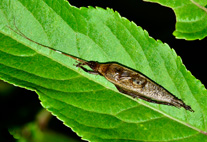Abstract
Eight new species of the genus Paranura are described from temperate zone of Holarctic. Five of them: Paranura reticulata sp. nov., Paranura oregonensis sp. nov., Paranura reducta sp. nov., Paranura cassagnaui sp. nov. and Paranura microchaetosa sp. nov. were found in coniferous forests of Oregon state, USA. Three others: Paranura kedrovayensis sp. nov., Paranura setosa sp. nov. and Paranura conjuncta sp. nov. were collected in mixed woods of Russian Far East. All new species are illustrated in detail and compared with existing taxa. P. reticulata sp. nov. is characterised by having three ocular chaetae, relatively short chaeta F on head, four ordinary chaetae De on th. III and three chaetae Di in abd. V (in s-uenoi two chaetae). The presence of only one ordinary chaeta De on abdomen IV is the most characteristic and recognizable character of P. oregonensis sp. nov. P. reducta sp. nov. is most diagnostically recognized by labral chaetotaxy, with only 4 chaetae. The species is true saproxylic form living inside decayed logs of coniferous trees only. P. cassagnaui sp. nov. is easy to distinguish by the presence of complete chaetotaxy of central area of head, presence of microchaetae on furcal remnant and the fusion of tubercles Di on abd. V. P. microchaetosa sp. nov. and P. kedrovayensis sp. nov. are superficially very similar to each other in dorsal chaetotaxy, and differ in number of ordinary chaetae De on abd. IV, trochanter and labium, and in the presence/absence of microchaetae on furcal remnant. P. setosa sp. nov. can be easily identified by one or two additional chaetae on central area of head, a character unknown in other species of the genus. P. conjuncta sp. nov. is characterised by the fusion of tubercles Di on abdomen V, the presence of microchaetae on furcal remnant and developed tubercle on central area of head. In addition, P. mjohjangensis Deharveng & Weiner, 1984 is newly recorded from Russia. An updated key to all world species of Paranura is also provided.

